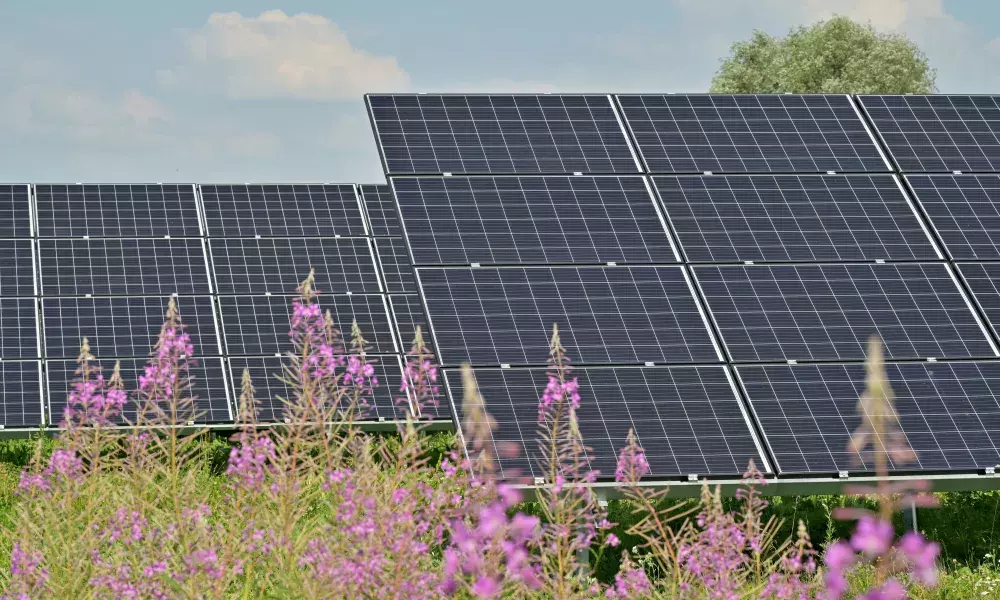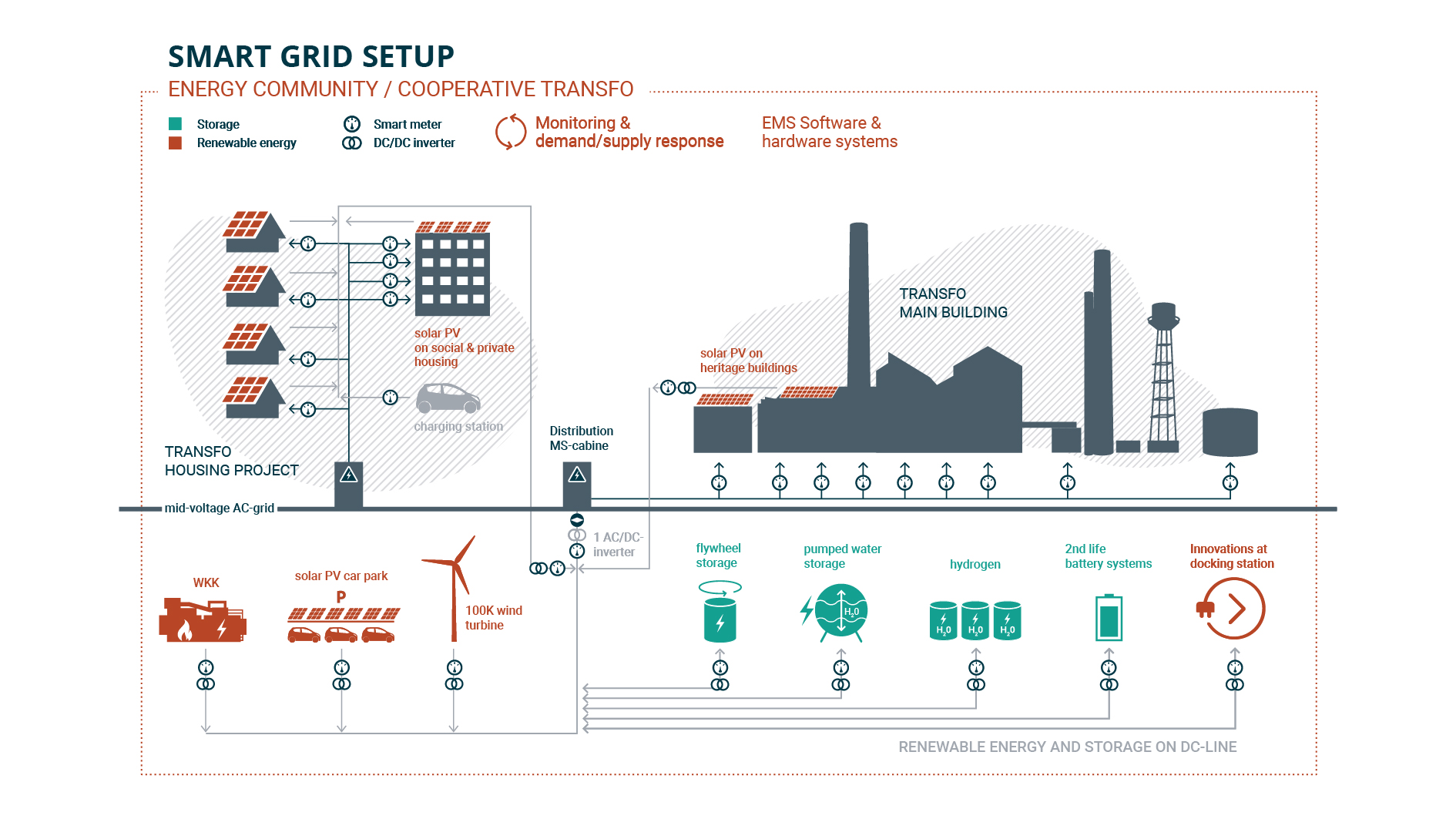
 RE/SOURCED has a Smart Grid at the heart of the system. The Smart Grid is an integral component of the wider urban development project. The Grid was designed to maximise the efficiency of renewable energy production on the site and has adopted a range of novel technologies, notably for energy storage. The Grid was also designed in a way that maximised the benefit for its users (both residential and commercial).
RE/SOURCED has a Smart Grid at the heart of the system. The Smart Grid is an integral component of the wider urban development project. The Grid was designed to maximise the efficiency of renewable energy production on the site and has adopted a range of novel technologies, notably for energy storage. The Grid was also designed in a way that maximised the benefit for its users (both residential and commercial).
This is an innovative and pioneering project. Delivering all aspects of the project has proven challenging and COVID-19 has also had an impact on the supply of technological components and systems.
RE/SOURCED comprises eight separate energy elements:
- three elements are “generating”
- four are “storage” and
- one, in many ways the most important, is the connecting grid linking the generation capacity with storage devices and end users.
The Smart Grid links the generating and storage elements together and enables the system to work effectively. It delivers electricity to the end users and it also provides a gateway to the public grid network.
There are two principal generating sources (Solar and Wind) and a third (Combined Heat & Power) that emerged as an opportunity after the original concept for RE/SOURCED was crafted.
Solar PV Array
The Solar PV array will be principally comprise an installation on the car park roof although there will be subsidiary installations on the roofs of the main heritage buildings (part of the original Transfo Electricity Generation plant) and on a new climbing hall to be constructed on the site. The capacity of the Solar PV array is circa 400 kW.
The car park structure will be repurposed from a previous location within the region thereby supporting Transfo’s Circular Economy principles.
Wind Turbine
A 100 kW wind turbine will be installed at the edge of the site.
Combined Heat & Power Plant (CHP)
The CHP plant generates heat and if required, electricity. It does this by burning sustainably sourced wood pellets.
The CHP was not included in the original proposal. However, the opportunity arose to "re-use” a power plant that was previously installed nearby. Its inclusion within the RE/SOURCED proposal adds value to the overall energy mix of the system. As with the car park structure above, reusing the existing CHP system supports Transfo’s Circular Economy principles. The CHP is being recommissioned and updated prior to being installed at Transfo.
The four “storage” elements are innovative and pioneering. Typically electricity storage has used battery packs with units such as the Tesla Powerwall being the most widely promoted. RE/SOURCED does more – it has identified four storage technologies (including batteries) that will work in parallel. The RE/SOURCED project is testing the suitability of these systems and also assessing how effectively the 400V DC backbone can support the integrated working of these technologies.
Flywheel
Flywheel technologies were originally anticipated to be included in the “storage mix”. However, due to COVID supply chain challenges, their acquisition is currently on hold.
Pumped Water Storage
The old Transfo coal fired power system incorporated a 43m high water tower to provide the facility with a ready supply of pressurised water. Although the storage tank was refurbished in 2020, it needs to be re-sealed for its new use through RE/SOURCED. Existing piping and systems will be reused in keeping with the project’s Circular Economy principles. Given its height, it was estimated to have the potential to generate up to 11kW and it was proposed to use an in-line small scale turbine to generate electricity for shorter periods, for example for peak shaving. In addition, the pumped storage demonstrator makes a very important educational contribution to the project.
However, while incorporating pumped storage is a goal of the project, the use of this technology has proven to be problematic to include in practice. Tenders have been issued three times but have generated no responses from potential suppliers, despite indications from them that the opportunity is of interest. Feedback suggests that there are two factors at play - the tender value is too small to be attractive to firms that might provide the equipment (especially when compared to other opportunities in the current buoyant market) and administrative effort required to respond to a formal public procurement process is too great.
The project is therefore having to consider whether it will be feasible to include this storage element going forward. It may be that its provision is achieved through another funding route (e.g. using technical or scientific research funding) at a later date
Hydrogen
Hydrogen is part of climate discussions for hard-to-decarbonize sectors and as a store of electricity. Specifically, it is increasingly being proposed as a carbon-free energy source for transport. However, energy is required to produce the Hydrogen and the generation process has tended to use fossil fuels. This has resulted in significant energy emissions. Hydrogen produced using carbon fuels is termed “blue hydrogen” while that created using Renewable sources is termed Green Hydrogen
RE/SOURCED will produce more electricity than local users can consume at certain times of the year (notably sunny and windy days). It is exploring whether Hydrogen production might be possible as a storage medium.
Second Life Batteries
Battery storage is presently the most widely used technology for storing renewably generated electricity. These are typically Lithium Ion units and are increasingly being offered commercially.
However, unlike typical commercial systems that use new batteries, RE/SOURCED will use second life batteries (that have previously been deployed for transportation etc) supporting its Circular Economy goals. While these batteries are no longer suitable for transport use (either because the storage capacity of the battery pack has been superseded or as the packs have become less efficient through use) they will be very suitable for the storage needs of the TRANSFO site.
There is a 400V “DC Backbone” – effectively a micro-grid circuit connecting the different elements of the system. Renewable Energy systems such as Solar PV Panels generate direct current. This must be converted to alternating current for most commercial and domestic uses. However, conversion is inefficient so it is best to keep the number of conversions to a minimum.
Using a 400V DC Backbone allows the renewably generated energy to be distributed efficiently, and potentially used directly (without conversion to AC) to charge electric vehicles (EV) for example. It also allows the energy to be stored without conversion thereby minimising losses in the storage process
Usually, with domestic generation systems, each house includes an inverter (to covert the DC to AC or AC to DC). With conventional domestic systems, each household has its own inverter. But inverters are inefficient so incur losses in the conversion process – and if every solar array had its own inverter, these losses would be considerable. RE/SOURCED addresses this challenge through using a single inverter to cover the whole site. This minimises conversion losses.
The project proposal anticipated that a local energy community would manage the shared infrastructure and operation
The project anticipated supporting the set-up of a legal entity that accommodates the definition of renewable energy and citizens energy communities as defined by the EU Clean Energy Package. Given the clearly defined geographic boundary and the mixed use of the site, it offered the potential to be a de-facto living lab for the Energy Community.
It subsequently transpired that there are legislative challenges preventing the Energy Co-Operative operating in a way that would benefit all users of the smart microgrid. That said, RE/SOURCED will create a not-for-profit organisation that enable local stakeholders to oversee and shape the operation of the microgrid. These issues will be covered in more depth in a future web article.
About this resource
The Urban Innovative Actions (UIA) is a European Union initiative that provided funding to urban areas across Europe to test new and unproven solutions to urban challenges. The initiative had a total ERDF budget of €372 million for 2014-2020.
Similar content



